Page 16 of 497
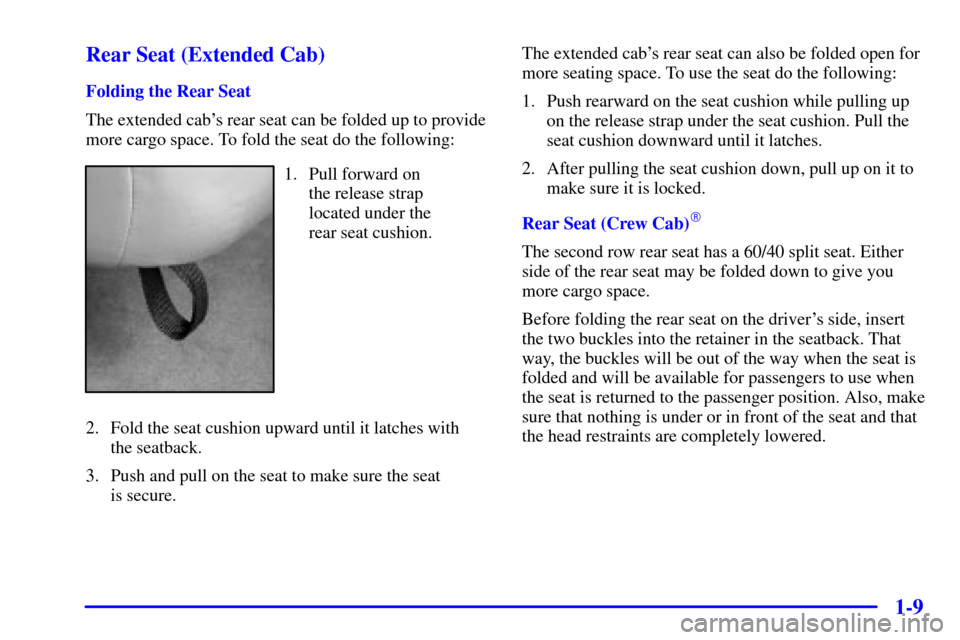
1-9 Rear Seat (Extended Cab)
Folding the Rear Seat
The extended cab's rear seat can be folded up to provide
more cargo space. To fold the seat do the following:
1. Pull forward on
the release strap
located under the
rear seat cushion.
2. Fold the seat cushion upward until it latches with
the seatback.
3. Push and pull on the seat to make sure the seat
is secure.The extended cab's rear seat can also be folded open for
more seating space. To use the seat do the following:
1. Push rearward on the seat cushion while pulling up
on the release strap under the seat cushion. Pull the
seat cushion downward until it latches.
2. After pulling the seat cushion down, pull up on it to
make sure it is locked.
Rear Seat (Crew Cab)
�
The second row rear seat has a 60/40 split seat. Either
side of the rear seat may be folded down to give you
more cargo space.
Before folding the rear seat on the driver's side, insert
the two buckles into the retainer in the seatback. That
way, the buckles will be out of the way when the seat is
folded and will be available for passengers to use when
the seat is returned to the passenger position. Also, make
sure that nothing is under or in front of the seat and that
the head restraints are completely lowered.
Page 17 of 497
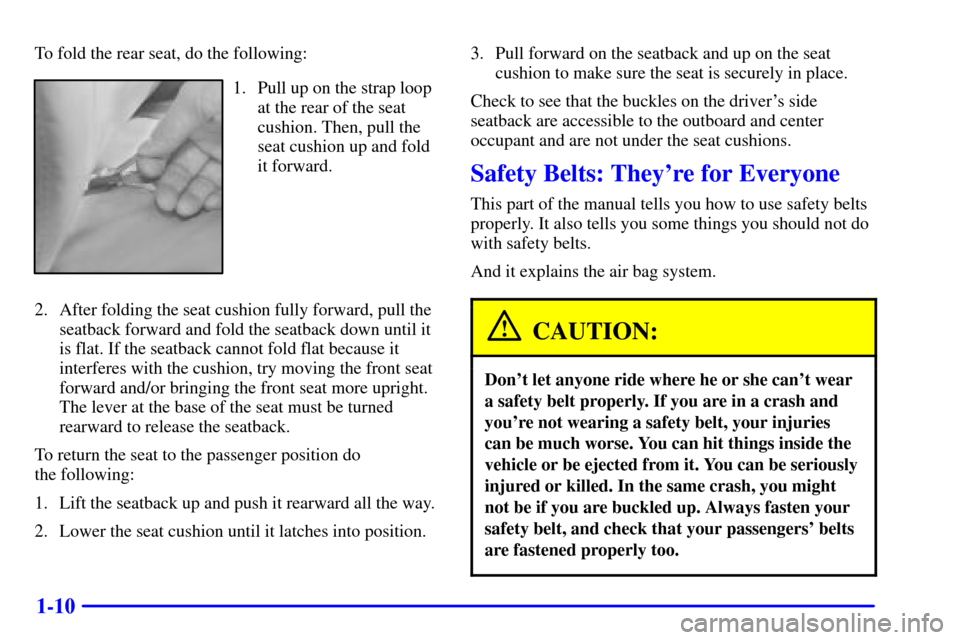
1-10
To fold the rear seat, do the following:
1. Pull up on the strap loop
at the rear of the seat
cushion. Then, pull the
seat cushion up and fold
it forward.
2. After folding the seat cushion fully forward, pull the
seatback forward and fold the seatback down until it
is flat. If the seatback cannot fold flat because it
interferes with the cushion, try moving the front seat
forward and/or bringing the front seat more upright.
The lever at the base of the seat must be turned
rearward to release the seatback.
To return the seat to the passenger position do
the following:
1. Lift the seatback up and push it rearward all the way.
2. Lower the seat cushion until it latches into position.3. Pull forward on the seatback and up on the seat
cushion to make sure the seat is securely in place.
Check to see that the buckles on the driver's side
seatback are accessible to the outboard and center
occupant and are not under the seat cushions.
Safety Belts: They're for Everyone
This part of the manual tells you how to use safety belts
properly. It also tells you some things you should not do
with safety belts.
And it explains the air bag system.
CAUTION:
Don't let anyone ride where he or she can't wear
a safety belt properly. If you are in a crash and
you're not wearing a safety belt, your injuries
can be much worse. You can hit things inside the
vehicle or be ejected from it. You can be seriously
injured or killed. In the same crash, you might
not be if you are buckled up. Always fasten your
safety belt, and check that your passengers' belts
are fastened properly too.
Page 24 of 497
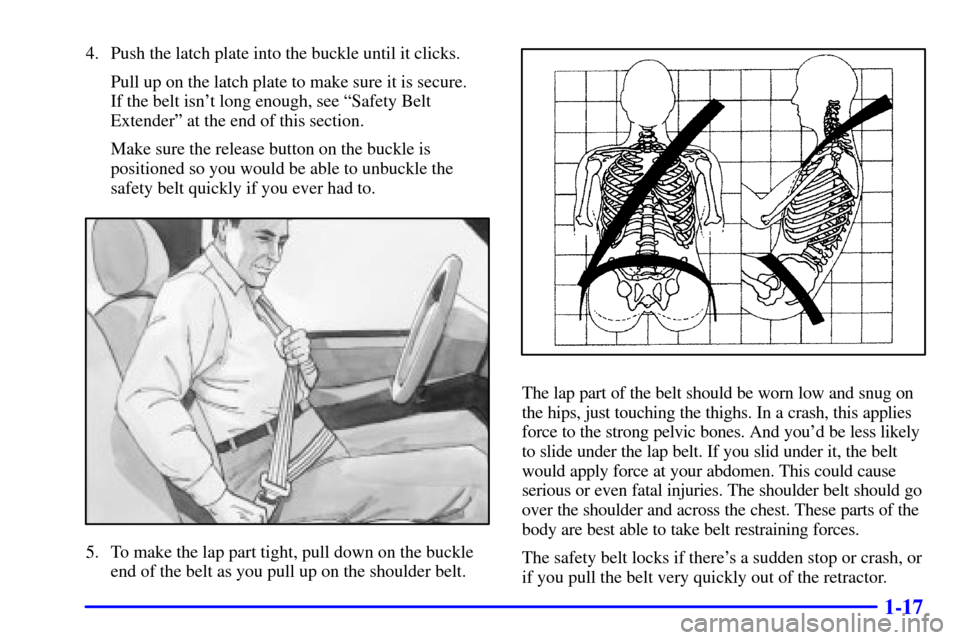
1-17
4. Push the latch plate into the buckle until it clicks.
Pull up on the latch plate to make sure it is secure.
If the belt isn't long enough, see ªSafety Belt
Extenderº at the end of this section.
Make sure the release button on the buckle is
positioned so you would be able to unbuckle the
safety belt quickly if you ever had to.
5. To make the lap part tight, pull down on the buckle
end of the belt as you pull up on the shoulder belt.
The lap part of the belt should be worn low and snug on
the hips, just touching the thighs. In a crash, this applies
force to the strong pelvic bones. And you'd be less likely
to slide under the lap belt. If you slid under it, the belt
would apply force at your abdomen. This could cause
serious or even fatal injuries. The shoulder belt should go
over the shoulder and across the chest. These parts of the
body are best able to take belt restraining forces.
The safety belt locks if there's a sudden stop or crash, or
if you pull the belt very quickly out of the retractor.
Page 32 of 497
1-25
CAUTION:
Air bags inflate with great force, faster than the
blink of an eye. If you're too close to an inflating
air bag, as you would be if you were leaning
forward, it could seriously injure you. Safety
belts help keep you in position before and during
a crash. Always wear your safety belt, even
with air bags. The driver should sit as far back
as possible while still maintaining control of
the vehicle.
CAUTION:
Anyone who is up against, or very close to, any
air bag when it inflates can be seriously injured
or killed. Air bags plus lap
-shoulder belts offer
the best protection for adults, but not for young
children and infants. Neither the vehicle's safety
belt system nor its air bag system is designed for
them. Young children and infants need the
protection that a child restraint system can
provide. Always secure children properly in your
vehicle. To read how, see the part of this manual
called ªChildren.º
Page 40 of 497
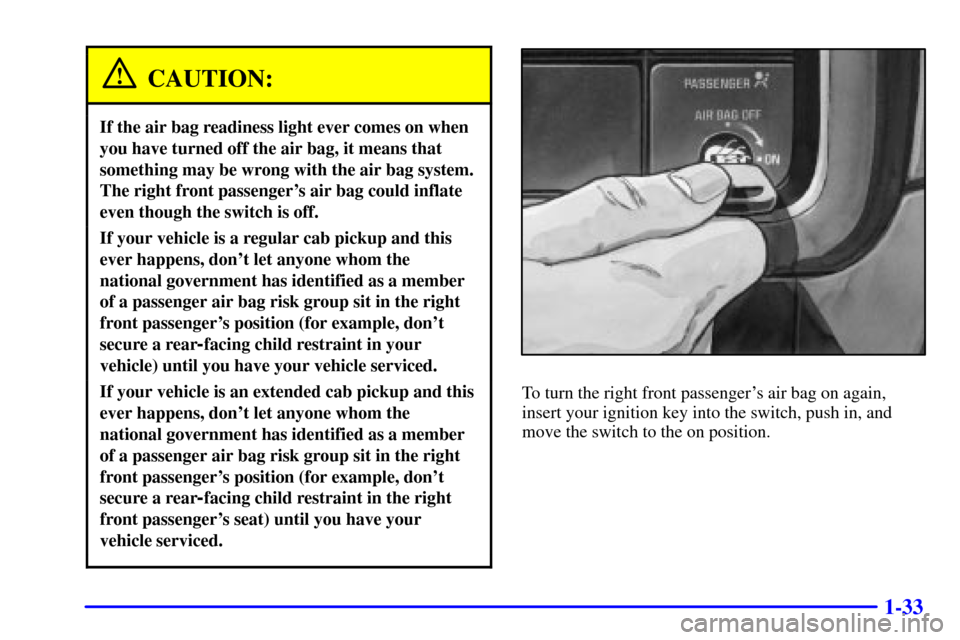
1-33
CAUTION:
If the air bag readiness light ever comes on when
you have turned off the air bag, it means that
something may be wrong with the air bag system.
The right front passenger's air bag could inflate
even though the switch is off.
If your vehicle is a regular cab pickup and this
ever happens, don't let anyone whom the
national government has identified as a member
of a passenger air bag risk group sit in the right
front passenger's position (for example, don't
secure a rear
-facing child restraint in your
vehicle) until you have your vehicle serviced.
If your vehicle is an extended cab pickup and this
ever happens, don't let anyone whom the
national government has identified as a member
of a passenger air bag risk group sit in the right
front passenger's position (for example, don't
secure a rear
-facing child restraint in the right
front passenger's seat) until you have your
vehicle serviced.
To turn the right front passenger's air bag on again,
insert your ignition key into the switch, push in, and
move the switch to the on position.
Page 44 of 497
1-37
Lap-Shoulder Belt (Extended Cab and Crew Cab)
The positions next to the windows have lap
-shoulder
belts. Here's how to wear one properly.
1. Pick up the latch plate and pull the belt across you.
Don't let it get twisted. The shoulder belt may lock if
you pull the belt across you very quickly. If this
happens, let the belt go back slightly to unlock it.
Then pull the belt across you more slowly.2. Push the latch plate into the buckle until it clicks.
Pull up on the latch plate to make sure it is secure.
When the shoulder belt is pulled out all the way, it
will lock. If it does, let it go back all the way and
start again.
If the belt is not long enough, see ªSafety Belt
Extenderº at the end of this section.
Make sure the release button on the buckle is
positioned so you would be able to unbuckle the
safety belt quickly if you ever had to.
Page 50 of 497
1-43
CAUTION:
People should never hold a baby in their arms
while riding in a vehicle. A baby doesn't weigh
much
-- until a crash. During a crash a baby will
become so heavy it is not possible to hold it.
CAUTION: (Continued)
CAUTION: (Continued)
For example, in a crash at only 25 mph
(40 km/h), a 12
-lb. (5.5 kg) baby will suddenly
become a 240
-lb. (110 kg) force on a person's
arms. A baby should be secured in an
appropriate restraint.
Page 52 of 497
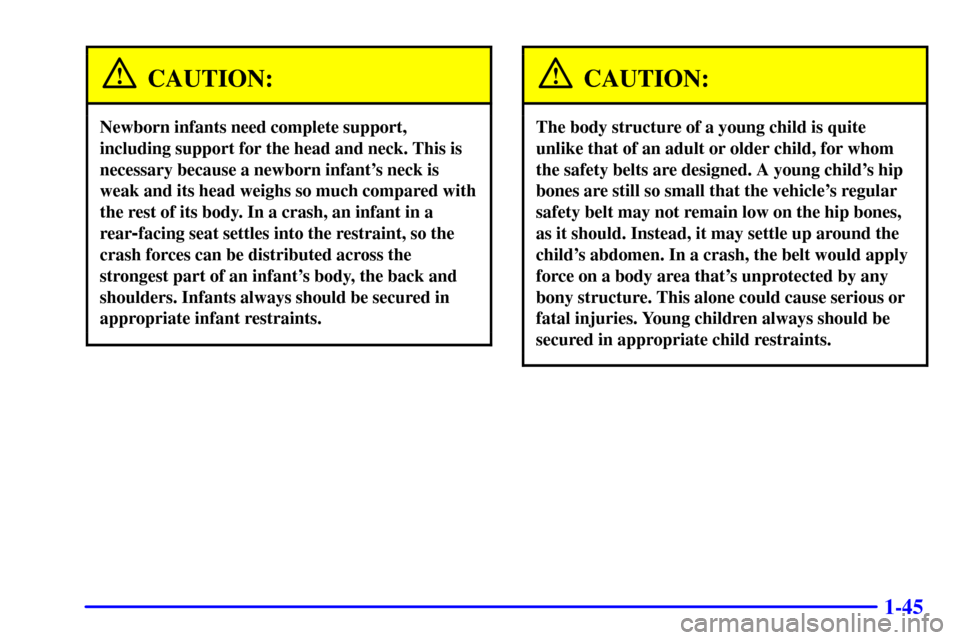
1-45
CAUTION:
Newborn infants need complete support,
including support for the head and neck. This is
necessary because a newborn infant's neck is
weak and its head weighs so much compared with
the rest of its body. In a crash, an infant in a
rear
-facing seat settles into the restraint, so the
crash forces can be distributed across the
strongest part of an infant's body, the back and
shoulders. Infants always should be secured in
appropriate infant restraints.
CAUTION:
The body structure of a young child is quite
unlike that of an adult or older child, for whom
the safety belts are designed. A young child's hip
bones are still so small that the vehicle's regular
safety belt may not remain low on the hip bones,
as it should. Instead, it may settle up around the
child's abdomen. In a crash, the belt would apply
force on a body area that's unprotected by any
bony structure. This alone could cause serious or
fatal injuries. Young children always should be
secured in appropriate child restraints.